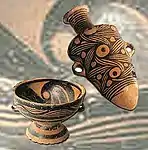 | |||||||
| Geographical range | upper Yellow River | ||||||
|---|---|---|---|---|---|---|---|
| Period | Neolithic China | ||||||
| Dates | c. 3300 – c. 2000 BC | ||||||
| Preceded by | Yangshao culture (5000-3000 BCE) | ||||||
| Followed by | Qijia culture | ||||||
| Chinese name | |||||||
| Simplified Chinese | 马家窑文化 | ||||||
| Traditional Chinese | 馬家窯文化 | ||||||
| |||||||
.png.webp)
The Majiayao culture was a group of neolithic communities who lived primarily in the upper Yellow River region in eastern Gansu, eastern Qinghai and northern Sichuan, China.[1] The culture existed from 3300 to 2000 BC. The Majiayao culture represents the first time that the upper Yellow River region was widely occupied by agricultural communities and it is famous for its painted pottery, which is regarded as a peak of pottery manufacturing at that time.
The Majiayao culture benefited from the warm and humid climatic conditions from the Late Glacial to the Middle Holocene, which led to flourishing agricultural production and rapid population growth. These conditions changed with the aridification of the Late Holocene, provoking material and cultural decline.[2]
The Majiayao culture may be associated with the expansion of early Sino-Tibetan peoples during the Neolithic.[3]
History
The archaeological site was first found in 1924 near the village of Majiayao in Lintao County, Gansu by Swedish archaeologist Johan Gunnar Andersson, who considered it part of the Yangshao culture.[1][4][5] Following the work of Xia Nai, the founder of modern archaeology in the People's Republic of China, it has since been considered a distinct culture, named after the original site, whereas previously it had been referred to as the "Gansu Yangshao" culture.[6] This culture developed from the middle Yangshao (Miaodigou) phase, through an intermediate Shilingxia phase.[1] The culture is often divided into three phases: Majiayao (3300–2500 BC), Banshan (2500–2300 BC) and Machang (2300–2000 BC).[7][8]
At the end of the 3rd millennium BC, the Qijia culture succeeded the Majiayao culture at sites in three main geographic zones: eastern Gansu, central Gansu, and western Gansu/eastern Qinghai.[9]
Location
Majiayao phase (3300–2500 BC) sites are mostly found on terraces along: the upper Wei River valley; upper Bailong River valley; middle and lower Tao River and Daxia River valleys; upper Yellow River valley; the Huangshui River; and lower Datong River.[10]
Pottery
The most distinctive artifacts of the Majiayao culture are the painted pottery. During the Majiayao phase, potters decorated their wares with designs in black pigment featuring sweeping parallel lines and dots. Pottery of the Banshan phase is distinguished by curvilinear designs using both black and red paints. Machang-phase pottery is similar, but often not as carefully finished.[14] Its development is associated with interaction between hunter-gatherers in the Qinghai region and the westward expansion of agricultural Yangshao people.[6]
In contrast to plain pottery, the Majiayao painted pottery was produced at large, centralised workshops. The largest Neolithic workshop found in China is at Baidaogouping, Gansu.[15] The manufacture of large amounts of painted pottery means there were professional craftspeople to produce it, which is taken to indicate increasing social complexity.[16] Control over the production process and quality declined by the Banshan phase, potentially due to greater demand for pottery to use in funeral rituals, similar to what Hung Ling-yu calls the "modern Wal-Mart syndrome".[17]
Pottery style emerging from the Yangshao culture spread to the Majiayao culture, and then further to Xinjiang and Central Asia.[18]
- Samples of Majiayao pottery from different phases
 Majiayao phase
Majiayao phase Banshan phase
Banshan phase Banshan phase
Banshan phase Machang phase
Machang phase
Symbolism
The Majiayao culture used a wide variety of symbols in its pottery, some of them abstract and geometric, including the well-known Neolithic symbol of the Swastika,[19][20] some of them figurative, such as frontal and rather realistic anthropomorphic depictions,[11][12] The Swastika symbol was particularly used during the final Majiayao Machang period (2300-2000 BCE), and became a current symbol in Buddhism representing samsara.[19] The symbols include net patterns, eight-angled star patterns, connected-shell patterns, petal patterns, vortex patterns etc...[21] Many motifs were already known from the preceding Yangshao culture (5000-3000 BCE).[22]
 Symbolic "Frog" pattern
Symbolic "Frog" pattern.jpg.webp) Machang Period Pottery (Swastika symbol)
Machang Period Pottery (Swastika symbol).jpg.webp) Pot with standing human shapes
Pot with standing human shapes.jpg.webp) Pot with 3-dimensional humanoid face
Pot with 3-dimensional humanoid face
Bronze
%252C_Gansu%252C_1978.jpg.webp)
_and_the_Central_Plains%252C_with_major_sites.png.webp)

Bronze technology was imported to China from the steppes.[24] The oldest bronze object found in China was a knife found at a Majiayao site in Dongxiang, Gansu, and dated to 2900–2740 BC.[25] Further copper and bronze objects have been found at Machang-period sites in Gansu.[26] Metallurgy spread to the middle and lower Yellow River region in the late 3rd millennium BC.[27] Contacts between the Afanasievo culture and the Majiayao culture and the Qijia culture have been considered for the transmission of bronze technology.[28]
Introduction of pastoralism
Domesticated cattle, sheep, and goats first appear in Western Asian circa 8000 BCE. Their introduction in China may have been through the Hexi Corridor during the Majiayao culture period, although an alternative may be a route through the Eurasian grasslands and then through the Mongolian plateau circa 3500-2500 BCE.[29]
Climate changes
Scholars have come to the conclusion that the development of the Majiayao culture was highly related to climate changes. A group of scholars from Lanzhou University have researched climate changes during the Majiayao culture and the results indicate that the climate was wet during 5830 to 4900 BP, which promoted the development of early and middle Majiayao culture in eastern Qinghai province. However, from 4900 to 4700 BP, the climate underwent droughts in this area, which may be responsible for the decline and eastward movement of prehistoric cultures during the period of transition from early-mid to late Majiayao culture.[30]
The transition from Yangshao to Majiayao coincides, climatically, with the Piora Oscillation.
See also
Notes
- 1 2 3 Liu & Chen (2012), p. 232.
- ↑ Li, Yu; Zhang, Zhansen; Zhou, Xueru; Gao, Mingjun; Li, Haiye; Xue, Yaxin; Duan, Junjie (1 May 2023). "Paleo-environmental changes and human activities in Shiyang River Basin since the Late Glacial". Chinese Science Bulletin: 3884. doi:10.1360/TB-2022-0965.
The long period of warm and humid climatic conditions from the Late Glacial to the Middle Holocene favoured the development and expansion of the Majiayao and Qijia cultures. This stable and agriculturally suitable climate was conducive to increased food production, which contributed to rapid population growth. However, the continuous aridification that began in the Late Holocene led to a decline in agricultural production and insufficient food and water supply, which hampered population growth and cultural development.
- ↑ Liu, Li; Chen, Jian; Wang, Jiajing; Zhao, Yanan; Chen, Xingcan (2022-12-20). "Archaeological evidence for initial migration of Neolithic Proto Sino-Tibetan speakers from Yellow River valley to Tibetan Plateau". Proceedings of the National Academy of Sciences. 119 (51): e2212006119. doi:10.1073/pnas.2212006119. ISSN 0027-8424. PMC 9907151. PMID 36508670.
- ↑ Andersson, Johan Gunnar (1943). Researches into the prehistory of the Chinese. Bulletin of the Museum of Far Eastern Antiquities. Vol. 15.
- ↑ Andersson, Johan Gunnar (1939). Topographical and Archaeological Studies in the Far East. Bulletin of the Museum of Far Eastern Antiquities. Vol. 11.
- 1 2 Hung 2011, p. 20.
- ↑ Liu & Chen (2012), pp. 216, 232.
- ↑ Dong, G.; et al. (2013). "The spatiotemporal pattern of the Majiayao cultural evolution and its relation to climate change and variety of subsistence strategy during late Neolithic period in Gansu and Qinghai Provinces, northwest China". Quaternary International. 316: 155–161. doi:10.1016/j.quaint.2013.07.038.
- ↑ Neolithic period Archived 2013-08-17 at the Wayback Machine -- Princeton University Art Museum
- ↑ Hung 2011, p. 27.
- 1 2 Childs-Johnson, Elizabeth (2020). The Oxford Handbook of Early China. Oxford University Press. p. 38. ISBN 978-0-19-932836-9.
- 1 2 Linduff, Katheryn M.; Sun, Yan (2004). Gender and Chinese Archaeology. Rowman Altamira. p. 42. ISBN 978-0-7591-0409-9.
- ↑ Insoll, Timothy (27 October 2011). The Oxford Handbook of the Archaeology of Ritual and Religion. OUP Oxford. p. 444. ISBN 978-0-19-923244-4.
- ↑ Valenstein (1989), pp. 6, 8.
- ↑ Hung 2011, p. 21.
- ↑ Hung 2011, p. 3–4.
- ↑ Hung 2011, p. 230.
- ↑ Zhang, Kai (4 February 2021). "The Spread and Integration of Painted pottery Art along the Silk Road". Region - Educational Research and Reviews. 3 (1): 18. doi:10.32629/RERR.V3I1.242. S2CID 234007445.
The early cultural exchanges between the East and the West are mainly reflected in several aspects: first, in the late Neolithic period of painted pottery culture, the Yangshao culture (5000-3000 BC) from the Central Plains spreadwestward, which had a great impact on Majiayao culture (3000-2000 BC), and then continued to spread to Xinjiang and Central Asia through the transition of Hexi corridor
- 1 2 Guozhen, Wang (1 December 2019). Collection of Ancient Chinese Cultural Relics, Volume 1: Primitive Society (1.7 million - 4000 BC) and The Xia and Shang Dynasties (21st - 11th Century BC). ATF Press. pp. 123, 115, v. ISBN 978-1-925371-29-1.
Four big circles are found on its belly, with the swastika pattern inside each circle.
- ↑ Yang, Xiaoneng (2000). Reflections of Early China: Decor, Pictographs, and Pictorial Inscriptions. Nelson-Atkins Museum of Art. ISBN 978-0-942614-30-5.
Both a cross notation and a swastika symbol are popular decorative patterns and marks on Machang phase pottery vessels.
- ↑ Guozhen, Wang (1 December 2019). Collection of Ancient Chinese Cultural Relics, Volume 1: Primitive Society (1.7 million - 4000 BC) and The Xia and Shang Dynasties (21st - 11th Century BC). ATF Press. ISBN 978-1-925371-29-1.
- ↑ Zheng, Dekun (1982). Studies in Chinese Archaeology. Chinese University Press. ISBN 978-962-201-279-0.
- ↑ Rawson, Jessica (2020). "Chariotry and Prone Burials: Reassessing Late Shang China's Relationship with Its Northern Neighbours". Journal of World Prehistory. 33: 138–168.
- ↑ Rawson, Jessica (April 2017). "China and the steppe: reception and resistance". Antiquity. 91 (356): 375–388. doi:10.15184/aqy.2016.276.
The development of several key technologies in China —bronze and iron metallurgy and horse-drawn chariots— arose out of the relations of central China, of the Erlitou period (c. 1700–1500 BC), the Shang (c.1500–1046 BC) and the Zhou (1046–771 BC) dynasties, with their neighbours in the steppe. Intermediaries in these exchanges were disparate groups in a broad border area of relatively high land around the heart of China, the Central Plains. The societies of central China were already so advanced that, when these foreign innovations were adopted, they were transformed within highly organised social and cultural systems.
- ↑ Bai (2003), p. 157.
- ↑ Liu & Chen (2012), p. 234.
- ↑ Liu (2005), p. 224.
- ↑ JIANJUN, MEI (2003). "Cultural Interaction between China and Central Asia during the Bronze Age" (PDF). Proceedings of the British Academy. 121: 1–39.
the argument for possible Afanasievo-Xinjiang contact based on the finds at the Gumugou cemetery in the north-eastern rim of the Tarim basin would seem reasonable and needs to be kept open for the future archaeological finds. In other words, the possibility for the dispersal of early copperbased metallurgy from the Eurasian steppe into Xinjiang and further east to Gansu cannot be excluded at present and will have to be considered when further archaeological evidence becomes available.
- ↑ Ren, Lele; Yang, Yishi; Qiu, Menghan; Brunson, Katherine; Chen, Guoke; Dong, Guanghui (1 August 2022). "Direct dating of the earliest domesticated cattle and caprines in northwestern China reveals the history of pastoralism in the Gansu-Qinghai region". Journal of Archaeological Science. 144: 105627. doi:10.1016/j.jas.2022.105627. ISSN 0305-4403.
Zooarchaeological and genetic research shows that the earliest domesticated cattle, sheep, and goats emerged in Western Asia and Northeast Africa at ∼10,000 cal BP (Loftus et al., 1994; Bradley et al., 1998; Zeder and Hesse, 2000; Marshall and Hildebrand 2002; Tong, 2004; Daly et al., 2018, 2021). During the past few decades, archaeologists have conducted many studies concerning the dating of the earliest domestic cattle, sheep, and goats in China (Yuan, 2015, 2021; Cai et al., 2018; Brunson et al., 2020; Hu, 2021). However, the timing and paths of early dispersal for domestic cattle and caprines into China are still unclear. One view is that domestic cattle and caprines were introduced into the Gansu-Qinghai (GQ) region from the Hexi Corridor during the Majiayao culture period (5600-5000BP), and then spread to other parts of China (Yuan, 2015, 2021). Another view is that domestic cattle and caprines spread eastward through the Eurasian grasslands, first passing through the Mongolian Plateau at ∼5500-4500 cal BP before moving south into China (Jaang 2015; Cai et al., 2018; Hu, 2021).
- ↑ "Climate Change; Researchers from Lanzhou University Describe Findings in Climate Change". The Business of Global Warming. Feb 20, 2012.
References
- Bai, Yunxiang (2003), "A Discussion on Early Metals and the Origins of Bronze Casting in China" (PDF), Chinese Archaeology, 3 (1): 157–165, doi:10.1515/CHAR.2003.3.1.157, S2CID 164920328.
- Hung, Ling-yu (2011), Pottery Production, Mortuary Practice, and Social Complexity in the Majiayao Culture, NW China (ca. 5300-4000 BP) (PhD), Washington University in St. Louis, doi:10.7936/K72V2D3J
- Liu, Li (2005), The Chinese Neolithic: Trajectories to Early States, Cambridge University Press, ISBN 978-0-521-81184-2.
- Liu, Li; Chen, Xingcan (2012), The Archaeology of China: From the Late Paleolithic to the Early Bronze Age, Cambridge University Press, ISBN 978-0-521-64310-8.
- Valenstein, Suzanne G. (1989), A Handbook of Chinese Ceramics (revised ed.), New York: Metropolitan Museum of Art, ISBN 978-0-87099-514-9.
.jpg.webp)